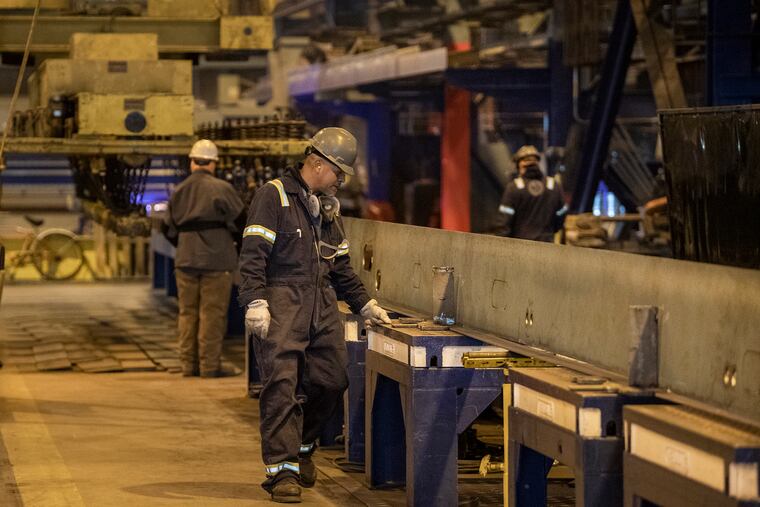For ‘middle-wage’ workers in Philly, finding a job can be harder than in other cities, according to a Pew report
Occupations traditionally available to people without college degrees with wages that can sustain a family are vital to an inclusive economic recovery from the pandemic, according to the report.

Over the last decade, about 1,600 people have graduated from a West Philadelphia-based workforce development program. The mission of the West Philadelphia Skills Initiative is to recruit workers, train them, and then place them in jobs that pay family-sustaining wages and offer career growth in major Philly employers such as SEPTA, the Philly Shipyard, and the Children’s Hospital of Philadelphia.
Graduates of the program become what’s known as “middle-wage” workers, a term used by economists to describe occupations traditionally available to people without college degrees and that offer wages that can sustain a family.
Although Philadelphia has lots of high-quality employers, many residents are underemployed or unemployed and struggling, said Cait Garozzo, executive director of the University City District’s West Philadelphia Skills Initiative.
The program is meant “to bridge that gap, to start to connect those that live in our city to the massive amounts of opportunity that exist here,” she said.
» READ MORE: A workforce program delivers more recruits to Philly Shipyard (From November 2021)
Middle-wage jobs “are vital to the idea of an inclusive [economic] recovery” from the pandemic, said Larry Eichel, senior adviser with the Pew Charitable Trusts’ Philadelphia research and policy initiative.
According to a report released Wednesday by the Pew Charitable Trusts, family-sustaining jobs in the middle of the income scale are harder to find in Philadelphia than in peer cities. The report looked at occupations that pay middle wages and their projected growth and compared Philadelphia with New York, Baltimore, Washington, San Francisco, and Nashville in the five years before the pandemic.
Pew defined “middle-wage jobs” as those that provided annual earnings of about $39,000 to $58,000 in the years leading up to the pandemic. Because of inflation and higher costs of living, the threshold for middle wage has since gone up.
About 145,000 of Philadelphia’s workers — 23% of the city’s workforce — had middle-wage jobs in the five years before the pandemic, according to the Pew Charitable Trusts. Two out of three of the city’s middle-wage workers were residents.
» READ MORE: How to be irresistible in today’s job market: Check out the skills in high demand
“Officials should monitor the data as they attempt to ensure that the city’s pandemic recovery does not result in stagnation for these jobs,” Eichel said. “These jobs are important.”
Below are some takeaways from the Pew Charitable Trusts’ report.
Middle-wage jobs are harder to find in Philadelphia
The percentage of workers earning middle wages in the cities that the Pew Charitable Trusts analyzed are relatively similar.
But Philadelphia has fewer middle-wage jobs compared with the size of its workforce, so middle-wage jobs are harder to find here.
» READ MORE: How to find a job in Philly
The city had just under 150 middle-wage jobs for every 1,000 working-age residents in the years before the pandemic, according to Pew. Baltimore, Washington, San Francisco, and Nashville had more than 200 for every 1,000 working-age residents. Only New York had fewer of these jobs per capita than Philadelphia — about 125.
The main reason for this is that Philadelphia has relatively fewer jobs overall compared with other cities, according to Pew. Of the six places the report analyzed, only Philadelphia had fewer jobs per capita than its larger metropolitan area in the years leading up to the pandemic. Jobs in the Philadelphia area are more spread out through surrounding counties.
Middle-wage job growth depends on growing the workforce
Health care support and community and social services are strong job sectors in Philadelphia’s economy, especially among residents, and middle-wage jobs in these industries are projected to grow, according to Pew.
But since various job sectors employ middle-wage workers at roughly the same rates, policy initiatives to grow specific sectors probably will not help much to grow middle-wage jobs overall, Eichel said.
» READ MORE: Philly’s ability to generate job growth could mean the difference between renaissance or stagnation
“What we found was that middle-wage job growth relies on overall job growth more than on the health of specific sectors,” he said. “If you help grow the economy overall, you’ll get additional middle-wage jobs.”
That’s the theory. But the report noted that the city’s number of middle-wage jobs did not grow significantly in the 2010s, even though Philadelphia was creating a lot of jobs.
The largest number of jobs paying middle wages are in office and administrative support
Almost 25,000 jobs in Philadelphia are in office and administrative support, including customer service representatives, administrative assistants, and office clerks. Those sectors contain the largest number of occupations in the city that pay middle wages.
» READ MORE: Empty offices could cause ‘fiscal doom loop’ in Philly and other big cities
These occupations saw lots of job losses during the pandemic and have not fully recovered, according to Pew. And local and national trends point to continued job losses among this group.
Occupations with the second- and third-highest numbers of middle-wage jobs in Philadelphia are in management and teaching. Some common occupations among Philadelphia’s middle-wage workers include truck drivers, social workers, and human resources workers.